Definition. A function
f from a set X to a set Y is a subset f of the product ![]() such that if
such that if ![]() , then
, then
![]() .
.
Instead of writing ![]() , you usually write
, you usually write ![]() . In ordinary terms, to say that an ordered pair
. In ordinary terms, to say that an ordered pair ![]() is in f means that x is the "input" to f
and y is the corresponding "output".
is in f means that x is the "input" to f
and y is the corresponding "output".
The requirement that ![]() implies
implies ![]() means that there is a unique output for each
input. (It's what is referred to as the "vertical line
test" for a graph to be a function graph.)
means that there is a unique output for each
input. (It's what is referred to as the "vertical line
test" for a graph to be a function graph.)
(Why not say, as in precalculus or calculus classes, that a function is a rule that assigns a unique element of Y to each element of X? The problem is that the word "rule" is ambiguous. The definition above avoids this by identifying a function with its graph.)
The notation ![]() means that f is a function from X to Y.
means that f is a function from X to Y.
X is called the domain, and Y is called the codomain. The image (or range) of f is the set of all outputs of the function:
![]()
Note that the domain and codomain are part of the definition of a function. For example, consider the following functions:
![]()
![]()
![]()
These are different functions; they're defined by the same rule, but they have different domains or codomains.
Example. Suppose ![]() is
given by
is
given by
![]()
Is this a function?
This does not define a function. For example, ![]() could be 3, since 3 is an integer bigger than 2.6.
But it could also be 4, or 67, or 101, or .... This "rule"
does not produce a unique output for each input.
could be 3, since 3 is an integer bigger than 2.6.
But it could also be 4, or 67, or 101, or .... This "rule"
does not produce a unique output for each input.
Mathematicians say that such a function --- or such an attempted
function --- is not well-defined.![]()
In basic algebra and calculus, functions ![]() are often
given by rules, without mention of a domain and codomain. In this
case, the natural domain ("domain"
for short) is the largest subset of
are often
given by rules, without mention of a domain and codomain. In this
case, the natural domain ("domain"
for short) is the largest subset of ![]() consisting of
numbers which can be "legally" plugged into the function.
consisting of
numbers which can be "legally" plugged into the function.
Example. Find the natural domain of
![]()
(i) I must have ![]() in order for
in order for ![]() to be defined.
to be defined.
(ii) I must have ![]() in order to avoid division by zero.
in order to avoid division by zero.
Hence, the domain of f is ![]() .
.![]()
Example. Define ![]() by
by
![]()
Prove that ![]() .
.
In words, the claim is that the outputs of y consist of all numbers other than 3. To see why 3 might be omitted, note that
![]()
That is, ![]() is a horizontal asymptote for the graph. Now this
isn't a proof, because a graph can cross a horizontal asymptote; it
just provides us with a "guess".
is a horizontal asymptote for the graph. Now this
isn't a proof, because a graph can cross a horizontal asymptote; it
just provides us with a "guess".
To prove ![]() , I'll show each set is
contained in the other.
, I'll show each set is
contained in the other.
Suppose ![]() . On scratch paper, I solve
. On scratch paper, I solve ![]() for x in terms of y and get
for x in terms of y and get ![]() . (This is defined, since
. (This is defined, since ![]() .) Now I prove that this input produces y as
an output:
.) Now I prove that this input produces y as
an output:
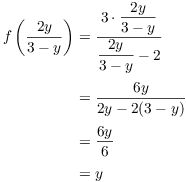
This proves that ![]() , so
, so ![]() .
.
Conversely, suppose ![]() , so
, so ![]() for some x. I
must show that
for some x. I
must show that ![]() . I'll use proof by contradiction: Suppose
. I'll use proof by contradiction: Suppose
![]() . Then
. Then
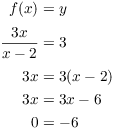
This contradiction proves ![]() . Thus,
. Thus, ![]() .
.
Therefore, ![]() .
.![]()
Definition. Let A, B, and C be sets, and let
![]() and
and ![]() be functions. The composite of f and g is the function
be functions. The composite of f and g is the function ![]() defined by
defined by
![]()
In my opinion, the notation "![]() " looks a lot like
multiplication, so (at least when elements are involved) I prefer to
write "
" looks a lot like
multiplication, so (at least when elements are involved) I prefer to
write "![]() " instead. However, the composite
notation is used often enough that you should be familiar with it.
" instead. However, the composite
notation is used often enough that you should be familiar with it.
Example. Define ![]() by
by ![]() and
and ![]() by
by ![]() . Find
. Find ![]() and
and ![]() .
.
![]()
![]()
Example. Define ![]() and
and
![]() by
by
![]()
Find:
(a) ![]() .
.
(b) ![]() .
.
(a)
![]()
(b)
![]()
If you get confused doing this, keep in mind two things:
(i) The variables used in defining a function are "dummy
variables" --- just placeholders. For example, ![]() defines the same function f as above.
defines the same function f as above.
(ii) The variables are "positional", so in "![]() " the "x" stands for "the first
input to f" and the "y" stands for "the second
input to f". In fact, you might find it helpful to rewrite the
definition of f this way:
" the "x" stands for "the first
input to f" and the "y" stands for "the second
input to f". In fact, you might find it helpful to rewrite the
definition of f this way:
![]()
Definition. Let X and Y be sets. A function
![]() is:
is:
(a) Injective if for all ![]() ,
, ![]() implies
implies ![]() .
.
(b) Surjective if for all ![]() , there is an
, there is an ![]() such that
such that ![]() .
.
(c) Bijective if it is injective and surjective.
Intuitively, a function is injective if different inputs give different outputs. The older terminology for "injective" was "one-to-one".
For functions ![]() , "injective" means
every horizontal line hits the graph at most once.
, "injective" means
every horizontal line hits the graph at most once.
A function is surjective if every element of the codomain (the "target set") is an output of the function. The older terminology for "surjective" was "onto".
For functions ![]() , "injective" means
every horizontal line hits the graph at least once.
, "injective" means
every horizontal line hits the graph at least once.
A function is bijective if the elements of the domain and the elements of the codomain are "paired up". The older terminology for "bijective" was "one-to-one correspondence".
For functions ![]() , "bijective" means
every horizontal line hits the graph exactly once.
, "bijective" means
every horizontal line hits the graph exactly once.
Note: These are useful pictures to keep in mind, but don't confuse them with the definitions!
Example. (a) Prove that ![]() given by
given by ![]() is neither injective nor
surjective.
is neither injective nor
surjective.
(b) Prove that ![]() given by
given by ![]() is not injective, but it is surjective.
is not injective, but it is surjective.
(c) Prove that ![]() given by
given by ![]() is injective and surjective.
is injective and surjective.
(a) It is not injective, since ![]() and
and ![]() : Different inputs may give the same output.
: Different inputs may give the same output.
It is not surjective, since there is no ![]() such that
such that ![]() .
.![]()
(b) It is not injective, since ![]() and
and ![]() : Different inputs may give the same output.
: Different inputs may give the same output.
It is surjective, since if ![]() ,
, ![]() is defined, and
is defined, and
![]()
(c) It is injective, since if ![]() , then
, then ![]() . But in this case,
. But in this case, ![]() , so
, so ![]() by taking square roots.
by taking square roots.
It is surjective, since if ![]() , then
, then ![]() is defined, and
is defined, and
![]()
Notice that in this example, the same "rule" --- ![]() --- was used, but whether the function was injective
or surjective changed. The domain and codomain are part of the
definition of a function.
--- was used, but whether the function was injective
or surjective changed. The domain and codomain are part of the
definition of a function.![]()
Example. Let ![]() be given by
be given by
![]()
Prove that f is injective.
Suppose ![]() and
and ![]() . I must prove
that
. I must prove
that ![]() .
.
![]() means that
means that ![]() .
Clearing denominators and doing some algebra, I get
.
Clearing denominators and doing some algebra, I get
![]()
Therefore, f is injective.![]()
Example. Let ![]() be
given by
be
given by
![]()
Prove that f is injective.
It would probably be difficult to prove this directly. Instead, I'll use the following fact:
Suppose ![]() is differentiable, and that
is differentiable, and that ![]() for all x or
for all x or ![]() for all x. Then f is
injective.
for all x. Then f is
injective.
In this case, note that, since even powers are nonnegative,
![]()
Since the derivative is always positive, f is always increasing, and
hence f is injective.![]()
Here's a proof of the result I used in the last example.
Proposition. Suppose ![]() is differentiable, and that
is differentiable, and that ![]() for all x or
for all x or ![]() for all x. Then f is
injective.
for all x. Then f is
injective.
Proof. Suppose that f is differentiable and
always increasing. Suppose that ![]() . I want to
prove that
. I want to
prove that ![]() .
.
Suppose on the contrary that ![]() . There's no harm in assuming
. There's no harm in assuming
![]() (otherwise, switch them). By the Mean Value Theorem,
there is a number c such that
(otherwise, switch them). By the Mean Value Theorem,
there is a number c such that ![]() and
and
![]()
Since ![]() and
and ![]() for all x,
for all x,

This contradiction proves that ![]() . Therefore, f is injective.
. Therefore, f is injective.
The same proof works with minor changes if ![]() for all x.
for all x.![]()
Example. Define ![]() by
by
![]()
Prove that f is surjective.
Note that ![]() is the real numbers other than 1.
is the real numbers other than 1.
Let ![]() . I have to show that there is an x such
that
. I have to show that there is an x such
that ![]() .
.
I work backwards on scratch paper:
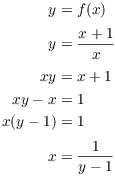
Note that this is not a proof --- I started with ![]() , which is what I want to show.
, which is what I want to show.
The last line tells me what I need to use for "x". To prove surjectivity, I plug it in and verify that it works. Remember that at this point, I've been given y. So

Thus, given ![]() , I have found an input to f which
produces y as an output. Therefore, f is surjective.
, I have found an input to f which
produces y as an output. Therefore, f is surjective.![]()
The preceding example relied on being able to solve for x in terms of y. In general, you can't expect to solve an arbitrary equation for one variable in terms of another. In some cases, it's possible to prove surjectivity indirectly.
Example. Define ![]() by
by ![]() . Show that f is not injective, but that f is
surjective. f is not injective, since
. Show that f is not injective, but that f is
surjective. f is not injective, since ![]() and
and ![]() .
.
The graph suggests that f is surjective. To say that every ![]() is an output of f means graphically that every
horizontal line crosses the graph at least once (whereas
injectivity means that every horizontal line crosses that
graph at most once).
is an output of f means graphically that every
horizontal line crosses the graph at least once (whereas
injectivity means that every horizontal line crosses that
graph at most once).

To prove that f is surjective, take ![]() . I must find
. I must find
![]() such that
such that ![]() , i.e. such that
, i.e. such that ![]() .
.
The problem is that finding x in terms of y involves solving a cubic equation. This is possible, but it's easy to change the example to produce a function where solving algebraically is impossible in principle.
Instead, I'll proceed indirectly.
![]()
It follows from the definition of these infinite limits that there are numbers a and b such that
![]()
The existence of a comes from ![]() , which means that
, which means that ![]() must eventually become smaller than any number y as
must eventually become smaller than any number y as
![]() . Likewise, the existence of b comes from
. Likewise, the existence of b comes from ![]() , which means
that
, which means
that ![]() must eventually become larger than any number y as
must eventually become larger than any number y as
![]() .
.
But f is continuous --- it's a polynomial --- so by the Intermediate
Value Theorem, there is a point c such that ![]() and
and ![]() . This proves that f is
surjective.
. This proves that f is
surjective.
Note, however, that I haven't found c; I've merely shown
that such a value c must exist.![]()
Example. Define
![]()
Prove that f is surjective, but not injective.
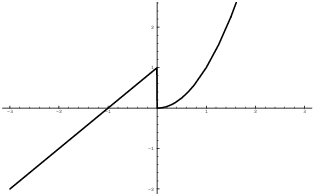
Let ![]() . If
. If ![]() , then
, then ![]() , so
, so
![]()
If ![]() , then
, then ![]() is defined and
is defined and ![]() , so
, so
![]()
This proves that f is surjective.
However,
![]()
Hence, f is not injective.![]()
Example. Consider the function ![]() defined by
defined by
![]()
Prove that f is neither injective nor surjective.
![]()
Therefore, f is not injective.
To prove f is not surjective, I must find a point ![]() which is not an output of f. I'll show that
which is not an output of f. I'll show that ![]() is not an output of f. Suppose on the contrary that
is not an output of f. Suppose on the contrary that
![]() . Then
. Then
![]()
This gives two equations:
![]()
Multiply the second equation by -2 to obtain ![]() . Now I have
. Now I have ![]() and
and ![]() , so
, so ![]() , a contradiction.
, a contradiction.
Therefore, there is no such ![]() , and f is not
surjective.
, and f is not
surjective.![]()
Example. Let ![]() be
defined by
be
defined by
![]()
Is f injective? Is f surjective?
First, I'll show that f is injective. Suppose ![]() . I have to show that
. I have to show that ![]() .
.
![]()
Equating the second components, I get ![]() . By taking cube
roots, I get
. By taking cube
roots, I get ![]() . Equating the first components, I get
. Equating the first components, I get ![]() . But
. But ![]() , so subtracting
, so subtracting ![]() I get
I get ![]() . Now taking the log of both sides
gives
. Now taking the log of both sides
gives ![]() . Thus,
. Thus, ![]() , and f is injective.
, and f is injective.
I'll show that f is not surjective by showing that there is no input
![]() which gives
which gives ![]() as an output. Suppose on the
contrary that
as an output. Suppose on the
contrary that ![]() . Then
. Then
![]()
Equating the second components gives ![]() , so
, so ![]() . Equating the first components gives
. Equating the first components gives ![]() . But
. But ![]() , so I get
, so I get ![]() . This is impossible, since
. This is impossible, since ![]() is always positive. Therefore, f is not surjective.
is always positive. Therefore, f is not surjective.![]()
Definition. Let S and T be sets, and let ![]() be a function from S to T. A function
be a function from S to T. A function ![]() is called the inverse of f if
is called the inverse of f if
![]()
Not all functions have inverses; if the inverse of f exists, it's
denoted ![]() . (Despite the crummy notation, "
. (Despite the crummy notation, "![]() " does not mean "
" does not mean "![]() ".)
".)
You've undoubtedly seen inverses of functions in other courses; for
example, the inverse of ![]() is
is ![]() . However, the functions I'm discussing may not have
anything to do with numbers, and may not be defined using formulas.
. However, the functions I'm discussing may not have
anything to do with numbers, and may not be defined using formulas.
Example. Define ![]() by
by ![]() . Find the
inverse of f.
. Find the
inverse of f.
To find the inverse of f (if there is one), set ![]() . Swap the x's and y's, then solve for y in
terms of x:
. Swap the x's and y's, then solve for y in
terms of x:
![]()
Thus, ![]() . To prove that this works
using the definition of an inverse function, do this:
. To prove that this works
using the definition of an inverse function, do this:


Recall that the graphs of f and ![]() are mirror images
across the line
are mirror images
across the line ![]() :
:
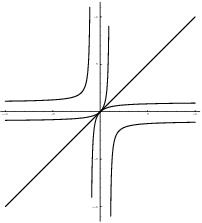
I'm mentioning this to connect this discussion to things you've
already learned. However, you should not make the mistake of
equating this special case with the definition. The
inverse of a function is not defined by "swapping x's
and y's and solving" or "reflecting the graph about ![]() ". A function might not involve numbers or
formulas, and a function might not have a graph. The inverse of a
function is what the definition says it is --- nothing more
or less.
". A function might not involve numbers or
formulas, and a function might not have a graph. The inverse of a
function is what the definition says it is --- nothing more
or less.![]()
Lemma. Let ![]() and
and ![]() be invertible functions. Then
be invertible functions. Then ![]() is invertible, and its inverse is
is invertible, and its inverse is
![]()
Proof. Let ![]() and let
and let ![]() . Then
. Then
![]()
![]()
This proves that ![]() .
.![]()
The next result relates bijectivity and inverses. I'll often use it in showing that a given function is bijective.
Theorem. Let S and T be sets, and let ![]() be a function. f is invertible if and only if f is
bijective.
be a function. f is invertible if and only if f is
bijective.
Proof. (![]() ) Suppose that
f is bijective. I'll construct the inverse function
) Suppose that
f is bijective. I'll construct the inverse function ![]() .
.
Take ![]() . Since f is surjective, there is an element
. Since f is surjective, there is an element ![]() such that
such that ![]() . Moreover, s is unique: If
. Moreover, s is unique: If
![]() and
and ![]() , then
, then ![]() . But f is
injective, so
. But f is
injective, so ![]() .
.
Define
![]()
I have defined a function ![]() . I must show that it is
the inverse of f.
. I must show that it is
the inverse of f.
Let ![]() . By definition of
. By definition of ![]() , to compute
, to compute ![]() I must find an element
I must find an element ![]() such that
such that ![]() .
But this is easy --- just take
.
But this is easy --- just take ![]() . Thus,
. Thus,
![]() .
.
Going the other way, let ![]() . By definition of
. By definition of ![]() , to compute
, to compute ![]() I
find an element
I
find an element ![]() such that
such that ![]() . Then
. Then ![]() , so
, so
![]()
Therefore, ![]() really is the inverse of f.
really is the inverse of f.
(![]() ) Suppose f has an inverse
) Suppose f has an inverse ![]() . I must show f is injective and surjective.
. I must show f is injective and surjective.
To show that f is surjective, take ![]() . Then
. Then ![]() , so I've found an element of S --- namely
, so I've found an element of S --- namely
![]() --- which f maps to t. Therefore, f is surjective.
--- which f maps to t. Therefore, f is surjective.
To show that f is injective, suppose ![]() and
and ![]() . Then
. Then
![]()
Therefore, f is injective.![]()
Corollary. The composite of bijective functions is bijective.
Proof. Since a function is bijective if and
only if it has an inverse, the corollary follows from the fact that
the composite of invertible functions is invertible.![]()
Example. Consider the function ![]() defined by
defined by
![]()
Show that f is injective and surjective by constructing an inverse
![]() .
.
I will work backwards on scratch paper and figure out a formula for the inverse. Then I'll prove that my formula works.
Scratch work: Suppose the inverse ![]() is
is
![]()
Now f and g are supposed to be inverses, so ![]() . So
. So
![]()
This gives
![]()
I want the formula for ![]() , which means I want to
find x and y in terms of u and v. Thus, I solve the two equations
above simultaneously. From
, which means I want to
find x and y in terms of u and v. Thus, I solve the two equations
above simultaneously. From ![]() , I get
, I get
![]()
That's x. Now plug this into ![]() and solve for y:
and solve for y:

Thus, the formula for g is
![]()
That ends the scratch work, and I do the "real proof".
Let ![]() . I must show
that
. I must show
that
![]()
First,
![$$\eqalign{ g(f(x, y)) & = g\left(2 x + y^3, x + 1\right) \cr & = ((x + 1) - 1, [(2 x + y^3) - 2(x + 1) + 2]^{1/3}) \cr & = (x, (2 x + y^3 - 2 x - 2 + 2)^{1/3}) \cr & = (x, (y^3)^{1/3}) \cr & = (x, y) \cr}$$](functions285.png)
Before doing the next equation, let's explain the second equality.
"![]() " means to plug
" means to plug
![]() in for y and
in for y and ![]() in for v in the definition
in for v in the definition
![]() . Check carefully
for yourself that we did that.
. Check carefully
for yourself that we did that.
Another important point: When you compute ![]() , there
should only be x's and y's in your work. You
can't have any u's and v's, because u and v aren't "global
variables" --- they don't exist outside of the definition of
, there
should only be x's and y's in your work. You
can't have any u's and v's, because u and v aren't "global
variables" --- they don't exist outside of the definition of
![]() .
.
Please look at the computation above and read the last paragraph again, because it is easy to make the mistake you're being warned about!
Next,
![$$\eqalign{ f(g(u, v)) & = f(v - 1, (u - 2 v + 2)^{1/3}) \cr & = (2(v - 1) + [(u - 2 v + 2)^{1/3}]^3, (v - 1) + 1) \cr & = (2 v - 2 + u - 2 v + 2, v) \cr & = (u, v) \cr}$$](functions292.png)
As in the previous derivation, I got the second equality by plugging
![]() in for x and
in for x and ![]() in for y in
in for y in ![]() .
.
By analogy with the first derivation, when you do ![]() , there should only be u's and v's
in your work --- you can't have any x's and y's.
, there should only be u's and v's
in your work --- you can't have any x's and y's.
The two equations above show that f and g are inverses. Therefore, f
is bijective.![]()
Copyright 2020 by Bruce Ikenaga